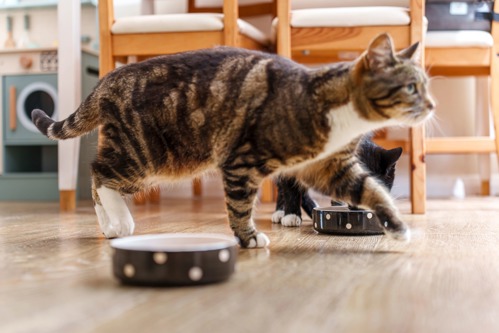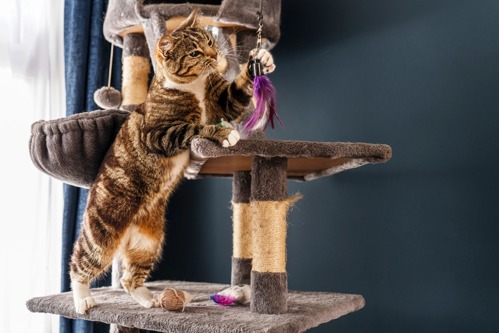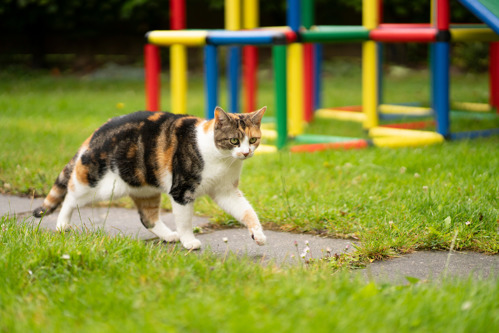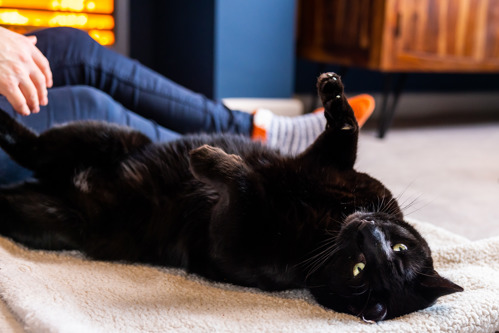All cats have a saggy belly pouch, but what is it for? Here’s everything you need to know about your cat’s primordial pouch
If you’ve ever watched your cat walking or running and noticed their belly swinging slightly from side to side, you may have worried that they are overweight. While a sagging belly can be a sign of weight gain, it could just be your cat’s primordial pouch. This is a normal part of every cat’s body. Read on to find out what this ‘belly pouch’ is for and how to tell the difference between a primordial pouch and a fat belly.
What is a cat’s primordial pouch?

The primordial pouch is a flap of loose skin, fatty tissue and fur that covers a cat’s belly. All cats, both male and female, have a primordial pouch, and even big cats such as lions and tigers have it too. The pouch develops when cats are around six months old and never goes away. It varies in size from cat to cat, some have a very noticeable pouch while on others it is much more difficult to see.
There is a myth that only cats who have been neutered develop a primordial pouch, but this isn’t true. This myth is likely to come from the fact that cats need to eat less after they have been neutered because they use less energy. If owners continue to feed their cat the same amount of food after neutering, the cat could put on weight and develop a large belly. This belly is sometimes mistaken for a primordial pouch.
Why do cats have a primordial pouch?

There are a few reasons why cats have evolved to have a belly pouch.
- Protection. If a cat gets into a fight with another cat or other animal, the loose skin and fatty tissue of the primordial pouch provides extra protection for vital organs such as the liver. When cats fight they sometimes ‘bunny kick’ with their back legs. The pouch adds an extra barrier between sharp claws and the cat’s insides. Find out more about cats and fighting. The primordial pouch is similar to the excess skin cats have on the back of their neck, also known as the ‘scruff’. Mum cats sometimes pick up their kittens by the scruff using their mouth. The extra skin protects against mum’s sharp teeth.
- Flexibility. The excess skin of the primordial pouch allows cats to stretch out their body further when they run or jump. This helps them to take longer strides when running and bigger leaps when jumping. It also means they can twist their body in mid-air to help them land on their feet.
- Food storage. If a cat eats a big meal, the primordial pouch allows their belly to expand to hold all that food. It’s similar to how we might undo our belt or the top button of our trousers to allow our belly to expand when we’ve eaten a lot. Most cats prefer to eat regular small meals throughout the day to avoid feeling too full. But in the wild they may have a bigger feast if food is otherwise scarce and they’re worried about when they will find their next meal. Find out more about feeding your cat.
Why is my cat’s primordial pouch so big?

Although it’s normal for cats to have a belly pouch, if their belly is looking particularly big or saggy then there could be another cause. If you notice any change in your cat’s body, it’s best to speak to your vet for advice in case there is a medical cause.
- Obesity. It can be easy to mistake a primordial pouch for a fat belly, but it’s important to know the difference. Overweight cats can be at greater risk of certain health conditions such as diabetes and arthritis. This can limit their life, so it’s better to tackle the problem early. The best way to tell if your cat is overweight is to assess their entire body. If you struggle to feel their ribs and spine because they are covered with a thick layer of fat, and notice that their waist and belly bulge out from behind their ribs, then they may be overweight. The belly of an overweight cat won’t sway as much as a primordial pouch when the cat walks or runs. It will also feel much firmer. If you’re unsure, you can ask your vet to assess your cat for you. Find more advice about cat obesity and how to help your cat lose weight.
- Pregnancy. If you have an unneutered female cat and notice that her belly is growing larger, it could be a sign that she is pregnant. The belly will start to swell when cats are around four to five weeks pregnant. If you think your cat might be pregnant, don’t try touching her belly as you could harm the unborn kittens. Instead ask your vet for advice. Find more advice about caring for pregnant cats.
- Aging. As in humans, a cat’s skin will start to lose elasticity as they age. This can cause their primordial pouch to become more saggy and noticeable as they get older. This is completely normal and nothing to worry about. But it’s a good idea to take your cat to the vet more often as they get older so that any health issues can be spotted early. Find more advice about caring for elderly cats.
Do cats like their primordial pouch rubbed?

Most cats don’t like having their belly touched or rubbed. Their belly is a vulnerable area and showing it to you usually isn’t an invitation to touch it. When a cat rolls over onto their back and shows you their belly, this is a sign that they are comfortable around you and trust you.
Although it can be very tempting to reach out and give their belly a rub, for most cats this would be a betrayal of trust. If you do touch their belly, they may try to grab your hand and attack it, or run away. When a cat does show you their belly, the best response is to try gently stroking their head or cheeks instead.
There will be some cats who are the exception to this rule and will enjoy a belly rub. If your cat remains still while you rub their belly and they are showing happy and relaxed body language, this is a good sign that they are enjoying it.



